|
|
|
Sort Order |
|
|
|
Items / Page
|
|
|
|
|
|
|
| Srl | Item |
| 1 |
ID:
188254
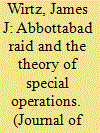

|
|
|
|
|
| Summary/Abstract |
When ‘The Theory of Special Operations’ was written in 1993 by then Commander William H. McRaven, USN, Al Qaeda was barely on the strategic horizon. Nevertheless, this thesis helped shape the denouement of the horrible tragedy that befell the world on 11 September 2001. This article describes McRaven’s work and traces its influence on the 2011 Abbottabad Raid. It also identifies how the theory might be modified to better capture the civil-military nexus at the apex of the strategic use of special operations forces.
|
|
|
|
|
|
|
|
|
|
|
|
|
|
|
|
| 2 |
ID:
127712
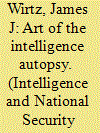

|
|
|
|
|
| Publication |
2014.
|
| Summary/Abstract |
Although intelligence postmortems are a common practice in the aftermath of intelligence failure, little is known about how they are conducted. This article explores the methodology employed by Robert Jervis in intelligence postmortems that followed the fall of the Shah of Iran in 1979 and the formulation of the 2002 Iraq national intelligence estimate that warned of the possibility that Iraq had restarted its nuclear program. The analysis reveals the challenges faced by scholars as they attempt to assess why analysts failed to offer accurate estimates and the way contemporary international relations theory can be applied to the realm of policy. The findings of the postmortems also shed light on areas where additional collaboration among scholars and analysts can advance the art of intelligence analysis.
|
|
|
|
|
|
|
|
|
|
|
|
|
|
|
|
| 3 |
ID:
107101
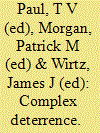

|
|
|
|
|
| Publication |
New Delhi, Cambridge University Press, 2011.
|
| Description |
x, 345p.
|
| Standard Number |
9788175967816, hbk
|
|
|
|
|
|
|
|
|
|
|
|
Copies: C:1/I:0,R:0,Q:0
Circulation
| Accession# | Call# | Current Location | Status | Policy | Location |
| 056218 | 327.73/PAU 056218 | Main | On Shelf | General | |
|
|
|
|
| 4 |
ID:
023131
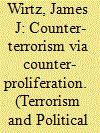

|
|
|
|
|
| Publication |
2002.
|
| Description |
129-140
|
|
|
|
|
|
|
|
|
|
|
|
|
|
|
|
| 5 |
ID:
178635
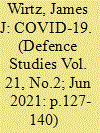

|
|
|
|
|
| Summary/Abstract |
This article offers strategic observations about the ongoing COVID-19 pandemic. It assesses whether the disease outbreak represents an intelligence failure. It describes how the global response to COVID-19 is an example of the so-called “spiral model” in action, whereby policy deliberations are overtaken by events. The analysis also assess how recent experience casts new light on assumptions common to the literature on biological weapons. It addresses the possibility that COVID-19 could spark a rise in cosmopolitan attitudes globally and offers reservations about using the COVID-19 experience as a future template for global pandemic response.
|
|
|
|
|
|
|
|
|
|
|
|
|
|
|
|
| 6 |
ID:
154860
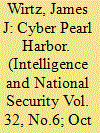

|
|
|
|
|
| Summary/Abstract |
The article describes the incentives that would motivate an opponent to incorporate a surprise cyber attack into a conventional operation to defeat US deterrent strategies by presenting the United States with a fait accompli. In describing this ‘Cyber Pearl Harbor’, the article explores the organizational and intelligence constraints that make it difficult to respond to the prospect of a combined cyber surprise attack and conventional operation. The article suggests that a cyber surprise attack will not occur in a political or strategic vacuum. Instead, weak opponents will use it to achieve objectives that could not be attained if US and allied forces were fully alerted.
|
|
|
|
|
|
|
|
|
|
|
|
|
|
|
|
| 7 |
ID:
159940
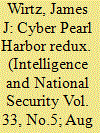

|
|
|
|
|
| Summary/Abstract |
This article defends the utility of employing the Pearl Harbor analogy to characterize contemporary cyber threats, especially threats facing the United States. It suggests that despite the fact that policy-makers are keenly aware of the nature of today’s cyber threats, this knowledge does not necessarily protect them from falling victim to a strategically significant cyber surprise attack. The fact that elected officials and senior officers fall victim to strategic surprise attacks launched by known adversaries is the problematique that animates the study of intelligence failure. The article concludes with the observation that just because scholars and policy-makers can imagine a ‘Cyber Pearl Harbor’ does not guarantee that they can avoid a Cyber Pearl Harbor.
|
|
|
|
|
|
|
|
|
|
|
|
|
|
|
|
| 8 |
ID:
067641
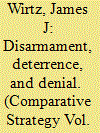

|
|
|
| 9 |
ID:
100930
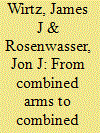

|
|
|
|
|
| Publication |
2010.
|
| Summary/Abstract |
Combined arms' operations have been a central tenet of military planning for nearly a century. They call for the integration of land, air and sea forces to achieve battlefield synergies. This philosophy has equal application to intelligence. The article advances the combined arms concept as a way to foster synergies across the intelligence disciplines - geospatial, signals, measures and signals, human, and most recently open source intelligence. It describes the strengths and weaknesses of each discipline in forming an analytical foundation for such a 'combined intelligence' and calls for developing theory to integrate the intelligence disciplines. The authors suggest that combined intelligence would confer several benefits, including more effective collection efforts and stronger countermeasures against adversary denial and deception. The article closes by calling for development of concepts and doctrine to put combined intelligence into practice.
|
|
|
|
|
|
|
|
|
|
|
|
|
|
|
|
| 10 |
ID:
081914
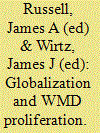

|
|
|
|
|
| Publication |
London, Routledge, 2008.
|
| Description |
xii, 170p.
|
| Series |
Routledge global security studies
|
| Standard Number |
9780415433945
|
|
|
|
|
|
|
|
|
|
|
|
Copies: C:1/I:0,R:0,Q:0
Circulation
| Accession# | Call# | Current Location | Status | Policy | Location |
| 053550 | 355.0217/RUS 053550 | Main | On Shelf | General | |
|
|
|
|
| 11 |
ID:
182034
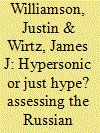

|
|
|
|
|
| Summary/Abstract |
Russian officials have spoken openly about their hypersonic weapons, touting them as the cornerstone of a new A2AD strategy. Questions remain, however, about the progress they have made in terms of “weaponizing” hypersonic technology. To assess the Russian hypersonic program, and the immediate threat its poses to U.S. Naval forces, the article describes the characteristics of hypersonic bodies. It then surveys the major systems under development by the Russians and the progress made in fielding those systems. It identifies limitations of the hypersonic systems show cased by Moscow and the possible motivations behind the Kremlin’s openness about their development.
|
|
|
|
|
|
|
|
|
|
|
|
|
|
|
|
| 12 |
ID:
187350
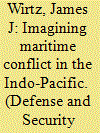

|
|
|
|
|
| Summary/Abstract |
Historical analogies are sometimes used to imagine the scope and nature of a potential conflict in the Indo-Pacific. Using analogies, scenarios, and “images” of future war, instead of strategy, however, can produce an inadequate assessment of future material, operational, and tactical requirements that will be encountered by the U.S. Navy in the maritime domain. Without a long-term strategy to set force development and guide operational requirements, the U.S. Navy will suffer from a “strategy deficit” when it comes to dealing with deterrence, coercion, and escalation in the Indo-Pacific. As planning guidance, the use of analogies is no substitute for strategy.
|
|
|
|
|
|
|
|
|
|
|
|
|
|
|
|
| 13 |
ID:
122916
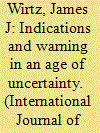

|
|
|
|
|
| Publication |
2013.
|
| Summary/Abstract |
Indications and warning intelligence is an important and time-tested methodology employed by intelligence analysts to warn military officers and policymakers about changes in an opponent's operational "posture" which indicate that the likelihood of dangerous or aggressive activity is increasing. In recent times, it has fallen out of fashion because policymakers and the public alike have come to expect that the Intelligence Community will be able to provide "specific event predictions" of an opponent's future actions. In other words, people tend to believe that intelligence analysts should be able to state who is about to undertake some unwanted activity, as well as where, how, when and why the action will unfold.
|
|
|
|
|
|
|
|
|
|
|
|
|
|
|
|
| 14 |
ID:
179029
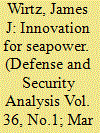

|
|
|
|
|
| Summary/Abstract |
A call for innovation as a means to outpace the acceleration of technological change and to bolster capabilities quickly is a central theme of contemporary U.S. Naval Strategy. The need for innovation is accepted, but the integration of readily available technologies into the Fleet is slow. Innovation unfolds according to “Navy-Time,” a cycle lasting between a long-decade and thirty-years. To accelerate the innovation process in the U.S. Navy, the article offers a Concept of Operations for Innovation that outlines how a deliberate process of analysis, weaponisation and integration can move new ideas and weapons into the Fleet in a strategically relevant time-frame.
|
|
|
|
|
|
|
|
|
|
|
|
|
|
|
|
| 15 |
ID:
154332
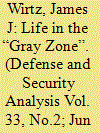

|
|
|
|
|
| Summary/Abstract |
The term “Gray Zone” is gaining in popularity as a way of describing contemporary security challenges. This article describes the “short-of-war” strategies – the fait accompli, proxy warfare, and the exploitation of ambiguous deterrence situations, i.e. “salami tactics” – that are captured by the term and offers several explanations for why state and non-state actors are drawn to these strategies. The analysis highlights why defense postures based on deterrence are especially vulnerable to the short-of-war strategies that populate the “Gray Zone.” The article concludes by suggesting how defense officials might adapt defense policies to life in the “Gray Zone.”
|
|
|
|
|
|
|
|
|
|
|
|
|
|
|
|
| 16 |
ID:
190367
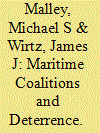

|
|
|
|
|
| Summary/Abstract |
When Bernard Brodie wrote his Guide to Naval Strategy in the early days of the Second World War, he emphasized that US naval operations in the Pacific had to secure bases close to the theater of operations around Japan in order to repair ships, resupply forces, and shift troops to a combat footing after traveling thousands of miles from the West Coast or even Hawaii.Footnote1 Today’s maritime strategists are in a better position when it comes to deterrence in the region. America’s friends and allies across the Indo-Pacific can provide US forces with facilities in peacetime, at the outset of a crisis, or during war.
|
|
|
|
|
|
|
|
|
|
|
|
|
|
|
|
| 17 |
ID:
188122
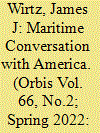

|
|
|
|
|
| Summary/Abstract |
Over the last century, the U.S. Navy has encountered critical moments when the emergence of new technologies and competitors cause paradigmatic shifts, undermining established operations and force structure. Today, the rise of an assertive China and its new anti-access and area-denial capabilities threaten the aircraft carrier-based maritime dominance of the U.S. Navy. Citizens and elected officials alike need to be conversant in the process to create the strategy, forces, and metrics needed to guarantee that the United States wins the emerging maritime competition in the Western Pacific. It is time to explain to the American public the enduring considerations and limitations that shape the operations of their global Navy.
|
|
|
|
|
|
|
|
|
|
|
|
|
|
|
|
| 18 |
ID:
188453
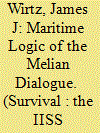

|
|
|
|
|
| Summary/Abstract |
There is a maritime logic embedded in Thucydides’ ‘Melian Dialogue’ that until now has attracted little notice; observers have instead concentrated on the deeper philosophical and moral issues highlighted by Thucydides in his tale drawn from the Peloponnesian War. Nevertheless, the maritime logic that propelled a confrontation on the island nation of Melos nearly 2,500 years ago could re-emerge in the run-up to a conflict in the Western Pacific. Allies are the strategic enabler of the US naval presence in the region, and US forces are taking steps to develop concepts and doctrine to enable operations in and along the First Island Chain. Denying access to these logistical facilities might be a political priority for China in the run-up to potential military action, and it would not be surprising if Beijing delivered a simple message to the inhabitants of the First Island Chain: stay out of it, and we will leave you out of it. All of this suggests that the idea of ‘neutrality’, as encountered in the Melian Dialogue, might again emerge during a crisis. Because the incentives to restrict US access to forward-operating bases are so clear-cut, strategists need to anticipate the emergence of ideas related to limiting the ability of US naval units to use port and air facilities in the Western Pacific.
|
|
|
|
|
|
|
|
|
|
|
|
|
|
|
|
| 19 |
ID:
067744
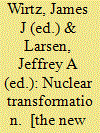

|
|
|
|
|
| Publication |
Hampshire, Palgrave Macmillan, 2005.
|
| Description |
xvi, 288p.
|
| Series |
Initiatives in strategic studies: issues and policies
|
| Standard Number |
1403969043
|
|
|
|
|
|
|
|
|
|
|
|
Copies: C:1/I:0,R:0,Q:0
Circulation
| Accession# | Call# | Current Location | Status | Policy | Location |
| 050713 | 355.02170973/WIR 050713 | Main | On Shelf | General | |
|
|
|
|
| 20 |
ID:
101221
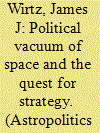

|
|
|
|
|
|
|
|